The Effects of Lake Level and Area Changes of Poyang Lake on the Local Weather
Abstract
:1. Introduction
2. Study Area, Data, and Model Configuration
2.1. Study Area
2.2. Data
2.3. Model Configuration
2.4. Reference Datasets
3. Results
3.1. Simulation Evaluations
3.2. Lake Effects on Surface Variables
3.2.1. Lake Effects on the Temporal Changes in the Surface Variables
3.2.2. Lake Effects on the Spatial Distribution of the Land Surface Variables
3.3. Lake Effects on the Near-Surface Variables
3.4. Lake Effects on Precipitation, Water Vapor Flux, and Wind
4. Discussion
5. Conclusions
- The change in the LH, the SH, and the LST when the lake level is low and the lake area is less is greater than when the lake level is high and the lake area is large. Compared to the default lake level and area in WRF, the spatial distribution of the LH, the SH, and the LST on the lake surface decreased when the lake level and area increased, and the domain-averaged LH, SH, and LST decreased by −10.4 W m−2, −1.1 W m−2, and −0.3 °C, respectively. The LH when the lake level is low and the lake area is small decreased by −11.2 W m−2. However, the SH and the LST increased by 13.4 W m−2 and 0.3 °C, respectively.
- The atmospheric stratification stability strengthens and the PBL decreases in the lake area as the lake level and area increase. In addition, the atmospheric stratification stability in the PBL shows an opposite change as the lake level and area decrease. The CAPE decreases on the west side of Poyang Lake but increases on the east side. These changes indicate that as the level and area of the lake change, the spatiotemporal distribution of surface heat, and thus the near-surface energy distribution, is changed.
- The water vapor flux and wind over the lake increase when the lake level and area increase, but the two variables increase when the lake level and area decrease. The wind over the lake weakened by 13.2 m s−1 as the lake level and area increased. When the low level and area of Poyang Lake decreased, the wind increased by 2.2 m s−1. These changes eventually led to a precipitation decrease when the lake level is high and the lake area large, with a domain-averaged decrease of −22.3 mm. In contrast, local circulation and water vapor flux when the lake level is low and the area small, which led to a precipitation decrease on the western side of the lake and a small increase on the eastern side, with a domain-averaged decrease of −23.8 mm.
Supplementary Materials
Author Contributions
Funding
Institutional Review Board Statement
Informed Consent Statement
Data Availability Statement
Acknowledgments
Conflicts of Interest
References
- Balsamo, G.; Salgado, R.; Dutra, E.; Boussetta, S.; Stockdale, T.; Potes, M. On the contribution of lakes in predicting near-surface temperature in a global weather forecasting model. Tellus A Dyn. Meteorol. Oceanogr. 2012, 64, 15829. [Google Scholar] [CrossRef]
- Long, Z.; Perrie, W.; Gyakum, J.; Caya, D.; Laprise, R. Northern lake impacts on local seasonal climate. J. Hydrometeorol. 2007, 8, 881–896. [Google Scholar] [CrossRef]
- Farley Nicholls, J.; Toumi, R. On the lake effects of the Caspian Sea. Q. J. R. Meteorol. Soc. 2014, 140, 1399–1408. [Google Scholar] [CrossRef]
- Ma, Y.; Yang, Y.; Qiu, C.; Wang, C. Evaluation of the WRF-Lake Model over Two Major Freshwater Lakes in China. J. Meteorol. Res. 2019, 33, 219–235. [Google Scholar] [CrossRef]
- Sun, X.; Xie, L.; Semazzi, F.; Liu, B. Effect of lake surface temperature on the spatial distribution and intensity of the precipitation over the Lake Victoria basin. Mon. Weather Rev. 2015, 143, 1179–1192. [Google Scholar] [CrossRef]
- Tsujimoto, K.; Koike, T. Land-lake breezes at low latitudes: The case of Tonle Sap Lake in Cambodia. J. Geophys. Res. Atmos. 2013, 118, 6970–6980. [Google Scholar] [CrossRef]
- Angel, J.R.; Isard, S.A. The frequency and intensity of Great Lake cyclones. J. Clim. 1998, 11, 61–71. [Google Scholar] [CrossRef]
- Owens, N.D.; Rauber, R.M.; Jewett, B.F.; McFarquhar, G.M. The contribution of lake enhancement to extreme snowfall within the Chicago–Milwaukee urban corridor during the 2011 Groundhog Day blizzard. Mon. Weather Rev. 2017, 145, 2405–2420. [Google Scholar]
- Schroeder, J.J.; Kristovich, D.A.; Hjelmfelt, M.R. Boundary layer and microphysical influences of natural cloud seeding on a lake-effect snowstorm. Mon. Weather Rev. 2006, 134, 1842–1858. [Google Scholar] [CrossRef]
- Alcott, T.I.; Steenburgh, W.J.; Laird, N.F. Great Salt Lake–effect precipitation: Observed frequency, characteristics, and associated environmental factors. Weather Forecast. 2012, 27, 954–971. [Google Scholar] [CrossRef]
- Laird, N.F.; Desrochers, J.; Payer, M. Climatology of lake-effect precipitation events over Lake Champlain. J. Appl. Meteorol. Climatol. 2009, 48, 232–250. [Google Scholar] [CrossRef] [Green Version]
- Dai, Y.; Yao, T.; Li, X.; Ping, F. The impact of lake effects on the temporal and spatial distribution of precipitation in the Nam Co basin, Tibetan Plateau. Quat. Int. 2018, 475, 63–69. [Google Scholar] [CrossRef]
- Yang, K.; Wang, J.; Lei, Y.; Chen, Y.; Zhu, L.; Ding, B.; Qin, J. Quantifying evaporation and its decadal change for Lake Nam Co, central Tibetan Plateau. J. Geophys. Res. Atmos. 2016, 121, 7578–7591. [Google Scholar]
- Eichenlaub, V.L. Lake effect snowfall to the lee of the Great Lakes: Its role in Michigan. Bull. Am. Meteorol. Soc. 1970, 51, 403–413. [Google Scholar] [CrossRef]
- Niziol, T.A.; Snyder, W.R.; Waldstreicher, J.S. Winter weather forecasting throughout the eastern United States. Part IV: Lake effect snow. Weather Forecast. 1995, 10, 61–77. [Google Scholar] [CrossRef]
- Huang, A.; Wang, J.; Dai, Y.; Yang, K.; Wei, N.; Wen, L.; Wu, Y.; Zhu, X.; Zhang, X.; Cai, S. Evaluating and improving the performance of three 1-D Lake models in a large deep Lake of the central Tibetan Plateau. J. Geophys. Res. Atmos. 2019, 124, 3143–3167. [Google Scholar] [CrossRef]
- Notaro, M.; Holman, K.; Zarrin, A.; Fluck, E.; Vavrus, S.; Bennington, V. Influence of the Laurentian Great Lakes on regional climate. J. Clim. 2013, 26, 789–804. [Google Scholar] [CrossRef]
- Liu, A.; Moore, G. Lake-effect snowstorms over southern Ontario, Canada, and their associated synoptic-scale environment. Mon. Weather Rev. 2004, 132, 2595–2609. [Google Scholar] [CrossRef]
- Steiner, A.L.; Posselt, D.J.; Wright, D.M. Sensitivity of Lake-Effect Snowfall to Lake Ice Cover and Temperature in the Great Lakes Region. Mon. Weather Rev. 2013, 141, 670–689. [Google Scholar]
- Gohm, A.; Umek, L. Lake and Orographic Effects on a Snowstorm at Lake Constance. Mon. Weather Rev. 2016, 144, 4687–4707. [Google Scholar]
- Small, E.E.; Giorgi, F.; Sloan, L.C.; Hostetler, S. The Effects of Desiccation and Climatic Change on the Hydrology of the Aral Sea. J. Clim. 2001, 14, 300–322. [Google Scholar] [CrossRef]
- Lauwaet, D.; Van Lipzig, N.; Van Weverberg, K.; De Ridder, K.; Goyens, C. The precipitation response to the desiccation of Lake Chad. Q. J. R. Meteorol. Soc. 2012, 138, 707–719. [Google Scholar] [CrossRef]
- Zhao, X.; Liu, Y. Variability of surface heat fluxes and its driving forces at different time scales over a large ephemeral lake in China. J. Geophys. Res. Atmos. 2018, 123, 4939–4957. [Google Scholar] [CrossRef]
- Sridhar, V. Tracking the influence of irrigation on land surface fluxes and boundary layer climatology. J. Contemp. Water Res. Educ. 2013, 152, 79–93. [Google Scholar] [CrossRef]
- Sridhar, V.; Anderson, K.A. Human-induced modifications to land surface fluxes and their implications on water management under past and future climate change conditions. Agric. For. Meteorol. 2017, 234, 66–79. [Google Scholar] [CrossRef]
- Haddeland, I.; Lettenmaier, D.P.; Skaugen, T. Effects of irrigation on the water and energy balances of the Colorado and Mekong river basins. J. Hydrol. 2006, 324, 210–223. [Google Scholar] [CrossRef]
- Guo, R.; Zhu, Y.; Liu, Y. A Comparison Study of Precipitation in the Poyang and the Dongting Lake Basins from 1960–2015. Sci. Rep. 2020, 10, 3381. [Google Scholar] [CrossRef]
- Junzhi, L.; A-Xing, Z.; Zheng, D. Evaluation of TRMM 3B42 Precipitation Product using Rain Gauge Data in Meichuan Watershed, Poyang Lake Basin, China. J. Resour. Ecol. 2012, 3, 359–366. [Google Scholar] [CrossRef]
- You, H.; Fan, H.; Xu, L.; Wu, Y.; Wang, X.; Liu, L.; Yao, Z.; Yan, B. Effects of Water Regime on Spring Wetland Landscape Evolution in Poyang Lake between 2000 and 2010. Water 2017, 9, 467. [Google Scholar] [CrossRef]
- Liu, H.; Zheng, L.; Jiang, L.; Liao, M. Forty-year water body changes in Poyang Lake and the ecological impacts based on Landsat and HJ-1 A/B observations. J. Hydrol. 2020, 589, 125161. [Google Scholar] [CrossRef]
- Yao, J.; Zhang, Q.; Ye, X.; Zhang, D.; Bai, P. Quantifying the impact of bathymetric changes on the hydrological regimes in a large floodplain lake: Poyang Lake. J. Hydrol. 2018, 561, 711–723. [Google Scholar] [CrossRef]
- Zhang, Q.; Ye, X.-C.; Werner, A.D.; Li, Y.-L.; Yao, J.; Li, X.-H.; Xu, C.-Y. An investigation of enhanced recessions in Poyang Lake: Comparison of Yangtze River and local catchment impacts. J. Hydrol. 2014, 517, 425–434. [Google Scholar] [CrossRef]
- Zhou, Y.; Jin, S.; Tenzer, R.; Feng, J. Water storage variations in the Poyang Lake Basin estimated from GRACE and satellite altimetry. Geod. Geodyn. 2016, 7, 108–116. [Google Scholar] [CrossRef]
- Dai, X.; Wan, R.; Yang, G. Non-stationary water-level fluctuation in China’s Poyang Lake and its interactions with Yangtze River. J. Geogr. Sci. 2015, 25, 274–288. [Google Scholar] [CrossRef] [Green Version]
- Liu, Y.; Wu, G.; Zhao, X. Recent declines in China’s largest freshwater lake: Trend or regime shift? Environ. Res. Lett. 2013, 8, 014010. [Google Scholar] [CrossRef]
- Feng, L.; Hu, C.; Chen, X.; Cai, X.; Tian, L.; Gan, W. Assessment of inundation changes of Poyang Lake using MODIS observations between 2000 and 2010. Remote Sens. Environ. 2012, 121, 80–92. [Google Scholar] [CrossRef]
- Yang, X.; Wu, J.; Liu, J.; Ye, X. Changes of Extreme Precipitation and Possible Influence of ENSO Events in a Humid Basin in China. Atmosphere 2021, 12, 1522. [Google Scholar] [CrossRef]
- Tao, H.; Fraedrich, K.; Menz, C.; Zhai, J. Trends in extreme temperature indices in the Poyang Lake Basin, China. Stoch. Environ. Res. Risk Assess. 2014, 28, 1543–1553. [Google Scholar] [CrossRef]
- Li, X.; Hu, Q. Spatiotemporal Changes in Extreme Precipitation and Its Dependence on Topography over the Poyang Lake Basin, China. Adv. Meteorol. 2019, 2019, 1253932. [Google Scholar] [CrossRef]
- Lei, X.; Gao, L.; Ma, M.; Wei, J.; Xu, L.; Wang, L.; Lin, H. Does non-stationarity of extreme precipitation exist in the Poyang Lake Basin of China? J. Hydrol. Reg. Stud. 2021, 37, 100920. [Google Scholar] [CrossRef]
- Zou, H.; Zhang, S.; Liu, Y.; Zhang, W.; Yang, X. Analysis of a Convective Storm Crossing Poyang Lake in China. J. Meteorol. Res. 2020, 34, 529–545. [Google Scholar] [CrossRef]
- Zou, H.; Wu, S.; Shan, J. Sensitivity of Lake-Effect Convection to the Lake Surface Temperature over Poyang Lake in China. J. Meteorol. Res. 2022, 36, 342–359. [Google Scholar] [CrossRef]
- Zhang, Z.; Chen, X.; Xu, C.-Y.; Hong, Y.; Hardy, J.; Sun, Z. Examining the influence of river–lake interaction on the drought and water resources in the Poyang Lake basin. J. Hydrol. 2015, 522, 510–521. [Google Scholar] [CrossRef]
- Pekel, J.F.; Cottam, A.; Gorelick, N.; Belward, A.S. High-resolution mapping of global surface water and its long-term changes. Nature 2016, 540, 418–422. [Google Scholar] [CrossRef]
- Wang, W.; Bruyère, C.; Duda, M.; Dudhia, J.; Gill, D.; Lin, H.-C. ARW Version 3 Modelling System User’s Guide. 2009. Available online: https://www2.mmm.ucar.edu/wrf/users/docs/user_guide_V3/contents.html (accessed on 1 August 2022).
- Subin, Z.M.; Riley, W.J.; Mironov, D. An improved lake model for climate simulations: Model structure, evaluation, and sensitivity analyses in CESM1. J. Adv. Modeling Earth Syst. 2012, 4, 2001. [Google Scholar] [CrossRef]
- Gu, H.; Jin, J.; Wu, Y.; Ek, M.B.; Subin, Z.M. Calibration and validation of lake surface temperature simulations with the coupled WRF-lake model. Clim. Chang. 2015, 129, 471–483. [Google Scholar] [CrossRef]
- Li, Z.; Gao, Y. Impact of Interaction between Metropolitan Area and Shallow Lake on Daily Extreme Precipitation over Eastern China. Atmosphere 2022, 13, 306. [Google Scholar] [CrossRef]
- Hong, S.-Y.; Lim, J.-O.J. The WRF single-moment 6-class microphysics scheme (WSM6). Asia-Pac. J. Atmos. Sci. 2006, 42, 129–151. [Google Scholar]
- Iacono, M.J.; Delamere, J.S.; Mlawer, E.J.; Shephard, M.W.; Clough, S.A.; Collins, W.D. Radiative forcing by long-lived greenhouse gases: Calculations with the AER radiative transfer models. J. Geophys. Res. Atmos. 2008, 113, D13. [Google Scholar] [CrossRef]
- Chen, F.; Dudhia, J. Coupling an advanced land surface–hydrology model with the Penn State–NCAR MM5 modeling system. Part I: Model implementation and sensitivity. Mon. Weather Rev. 2001, 129, 569–585. [Google Scholar] [CrossRef]
- Hong, S.-Y.; Noh, Y.; Dudhia, J. A new vertical diffusion package with an explicit treatment of entrainment processes. Mon. Weather Rev. 2006, 134, 2318–2341. [Google Scholar] [CrossRef]
- Grell, G.A.; Dévényi, D. A generalized approach to parameterizing convection combining ensemble and data assimilation techniques. Geophys. Res. Lett. 2002, 29, 38-1–38-4. [Google Scholar] [CrossRef]
- Hui, F.; Xu, B.; Huang, H.; Yu, Q.; Gong, P. Modelling spatial-temporal change of Poyang Lake using multitemporal Landsat imagery. Int. J. Remote Sens. 2008, 29, 5767–5784. [Google Scholar] [CrossRef]
- Stull, R.B. Static stability—An update. Bull. Am. Meteorol. Soc. 1991, 72, 1521–1530. [Google Scholar] [CrossRef]
- Laird, N.F.; Kristovich, D.A. Variations of sensible and latent heat fluxes from a Great Lakes buoy and associated synoptic weather patterns. J. Hydrometeorol. 2002, 3, 3–12. [Google Scholar] [CrossRef]
- Carpenter, D.M. The lake effect of the Great Salt Lake: Overview and forecast problems. Weather Forecast. 1993, 8, 181–193. [Google Scholar] [CrossRef]
- Dai, Y.; Wang, L.; Yao, T.; Li, X.; Zhu, L.; Zhang, X. Observed and simulated lake effect precipitation over the Tibetan Plateau: An initial study at Nam Co Lake. J. Geophys. Res. Atmos. 2018, 123, 6746–6759. [Google Scholar] [CrossRef]
- Lee, H.; Shum, C.K.; Tseng, K.-H.; Guo, J.-Y.; Kuo, C.-Y. Present-Day Lake Level Variation from Envisat Altimetry over the Northeastern Qinghai-Tibetan Plateau: Links with Precipitation and Temperature. Terr. Atmos. Ocean. Sci. 2011, 22, 169–175. [Google Scholar] [CrossRef]
- Steenburgh, W.J.; Halvorson, S.F.; Onton, D.J. Climatology of lake-effect snowstorms of the Great Salt Lake. Mon. Weather Rev. 2000, 128, 709–727. [Google Scholar] [CrossRef]
- Han, X.; Chen, X.; Feng, L. Four decades of winter wetland changes in Poyang Lake based on Landsat observations between 1973 and 2013. Remote Sens. Environ. 2015, 156, 426–437. [Google Scholar] [CrossRef]
- Huang, F.; Yan, B.; Zhang, X.; Zhao, D.; Guo, L.; Wang, Y.; Xia, Z. Water Regime Evolution of Large Seasonal Lakes: Indicators for Characterization and an Application in Poyang Lake, China. Int. J. Environ. Res. Public Health 2018, 15, 2598. [Google Scholar] [CrossRef] [PubMed]
- Jiang, X.; Wang, J.; Liu, X.; Dai, J. Landsat Observations of Two Decades of Wetland Changes in the Estuary of Poyang Lake during 2000–2019. Water 2022, 14, 8. [Google Scholar] [CrossRef]
- Partridge, T.F.; Winter, J.M.; Kendall, A.D.; Hyndman, D.W. Cross-scale evaluation of dynamic crop growth in WRF and Noah-MP-Crop. Agric. For. Meteorol. 2021, 296, 108217. [Google Scholar] [CrossRef]
- Warrach-Sagi, K.; Ingwersen, J.; Schwitalla, T.; Troost, C.; Aurbacher, J.; Jach, L.; Berger, T.; Streck, T.; Wulfmeyer, V. Noah-MP With the Generic Crop Growth Model Gecros in the WRF Model: Effects of Dynamic Crop Growth on Land-Atmosphere Interaction. J. Geophys. Res. Atmos. 2022, 127, e2022JD036518. [Google Scholar] [CrossRef]
- Xiao, C.; Lofgren, B.M.; Wang, J.; Chu, P.Y. Improving the lake scheme within a coupled WRF-lake model in the L aurentian G reat L akes. J. Adv. Modeling Earth Syst. 2016, 8, 1969–1985. [Google Scholar] [CrossRef]
- Li, S.; Gao, Y.; Lyu, S.; Liu, Y.; Pan, Y. Response of surface air temperature to the change of leaf area index in the source region of the Yellow River by the WRF model. Theor. Appl. Climatol. 2019, 138, 1755–1765. [Google Scholar] [CrossRef]
- Wang, X.; Li, Y.; Yan, M.; Gong, X. Changes in temperature and precipitation extremes in the arid regions of China, 1960–2016. Front. Ecol. Evol. 2022, 10, 902813. [Google Scholar] [CrossRef]
- Guan, Y.; Zhang, X.; Zheng, F.; Wang, B. Trends and variability of daily temperature extremes during 1960–2012 in the Yangtze River Basin, China. Glob. Planet. Chang. 2015, 124, 79–94. [Google Scholar] [CrossRef]
- Hong, L.; Si-rong, C.; Yuan, G.; Hui, H.; Sheng-xuan, X. Spatio-temporal variation characteristics of extremely heavy precipitation frequency over South China in the last 50 years. J. Trop. Meteorol. 2014, 20, 279. [Google Scholar]
- Shepherd, J.M.; Burian, S.J. Detection of urban-induced rainfall anomalies in a major coastal city. Earth Interact. 2003, 7, 1–17. [Google Scholar] [CrossRef]
- Bornstein, R.; Lin, Q. Urban heat islands and summertime convective thunderstorms in Atlanta: Three case studies. Atmos. Environ. 2000, 34, 507–516. [Google Scholar] [CrossRef]
- Diem, J.E.; Brown, D.P. Anthropogenic impacts on summer precipitation in central Arizona, USA. Prof. Geogr. 2003, 55, 343–355. [Google Scholar]
- Keeler, J.M.; Kristovich, D.A. Observations of urban heat island influence on lake-breeze frontal movement. J. Appl. Meteorol. Climatol. 2012, 51, 702–710. [Google Scholar] [CrossRef]
- Yang, L.; Smith, J.A.; Baeck, M.L.; Bou-Zeid, E.; Jessup, S.M.; Tian, F.; Hu, H. Impact of urbanization on heavy convective precipitation under strong large-scale forcing: A case study over the Milwaukee–Lake Michigan region. J. Hydrometeorol. 2014, 15, 261–278. [Google Scholar] [CrossRef]
- Wang, Y.; Gao, Y.; Qin, H.; Huang, J.; Liu, C.; Hu, C.; Wang, W.; Liu, S.; Lee, X. Spatiotemporal characteristics of lake breezes over Lake Taihu, China. J. Appl. Meteorol. Climatol. 2017, 56, 2053–2065. [Google Scholar] [CrossRef]
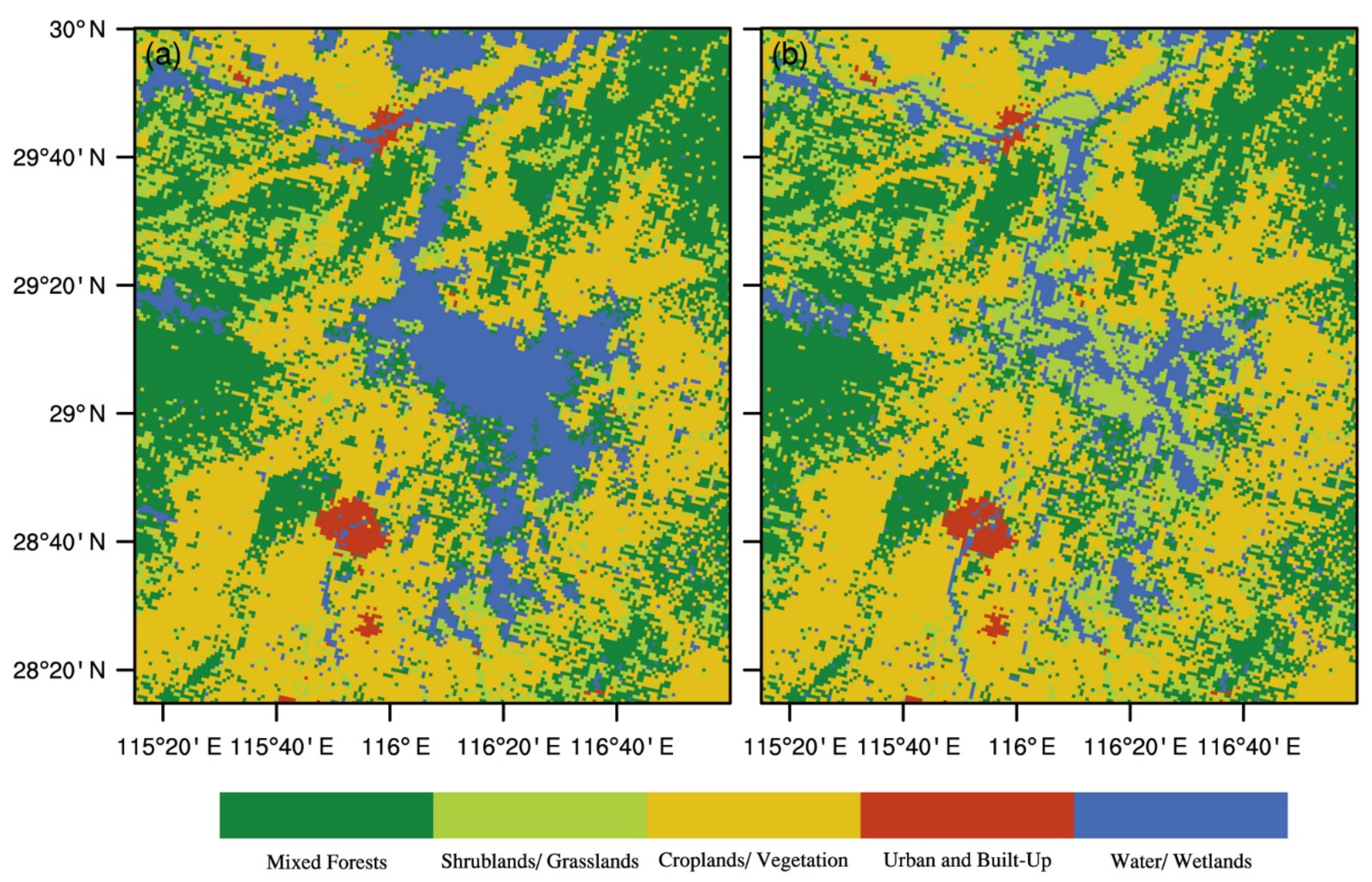
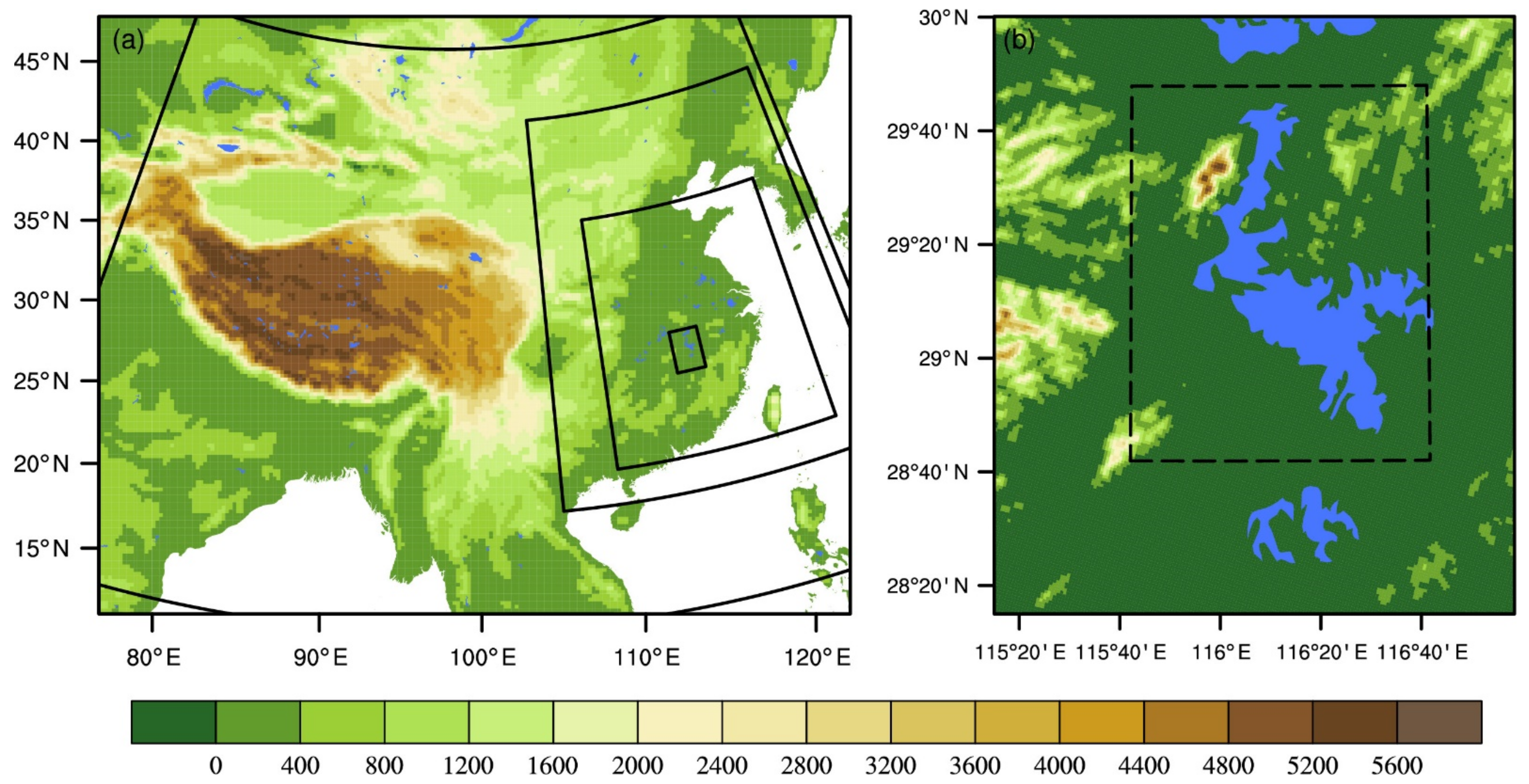

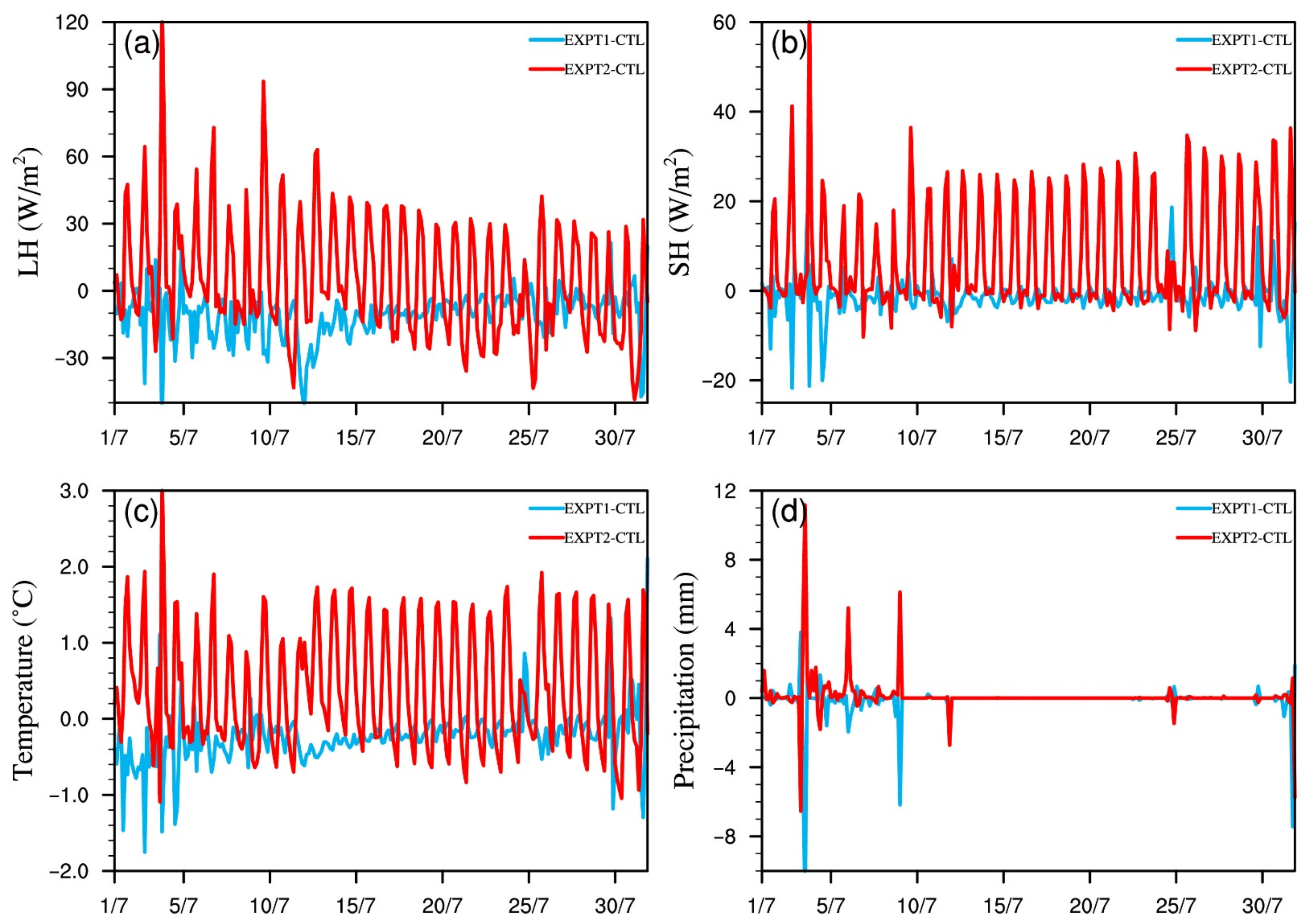
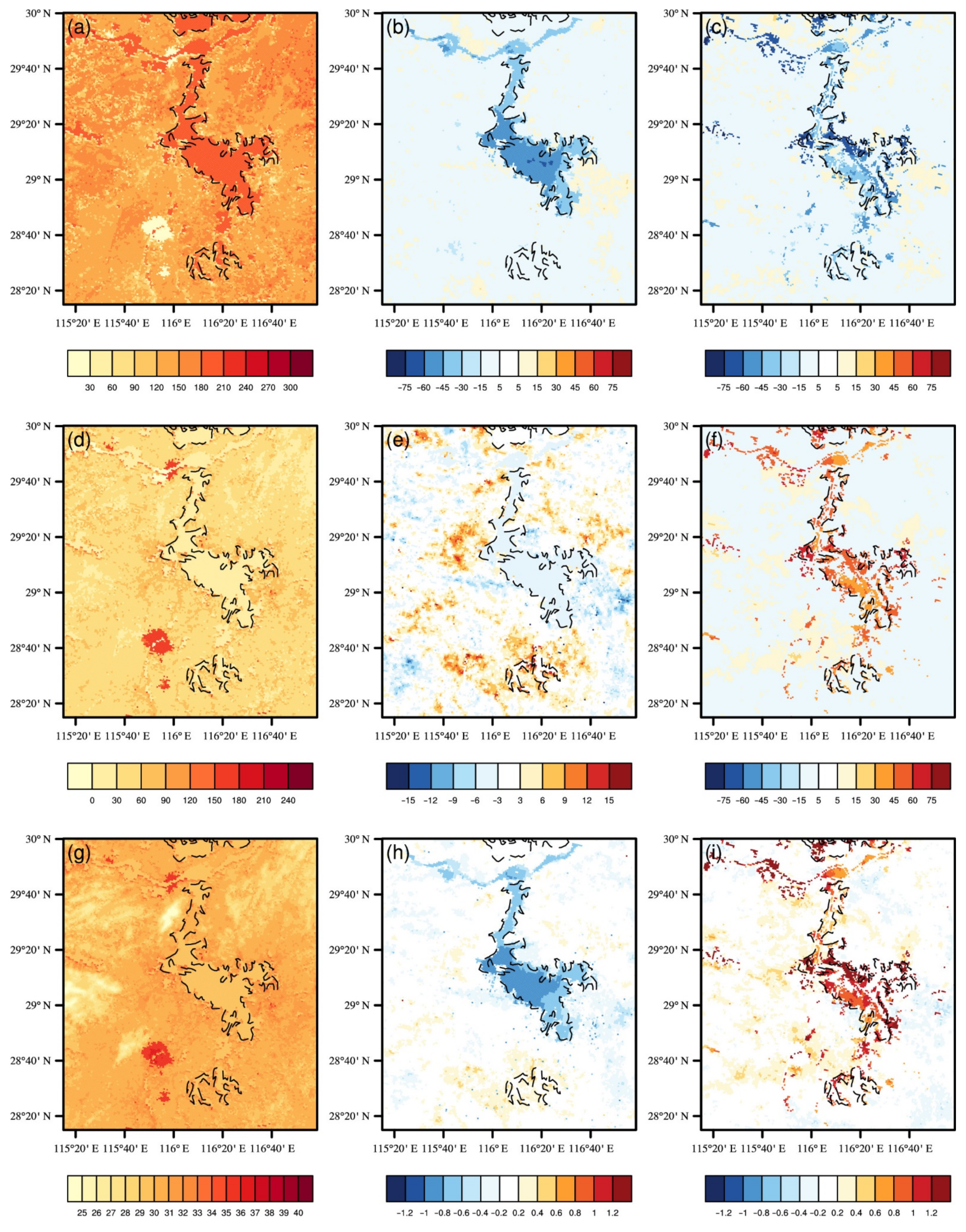
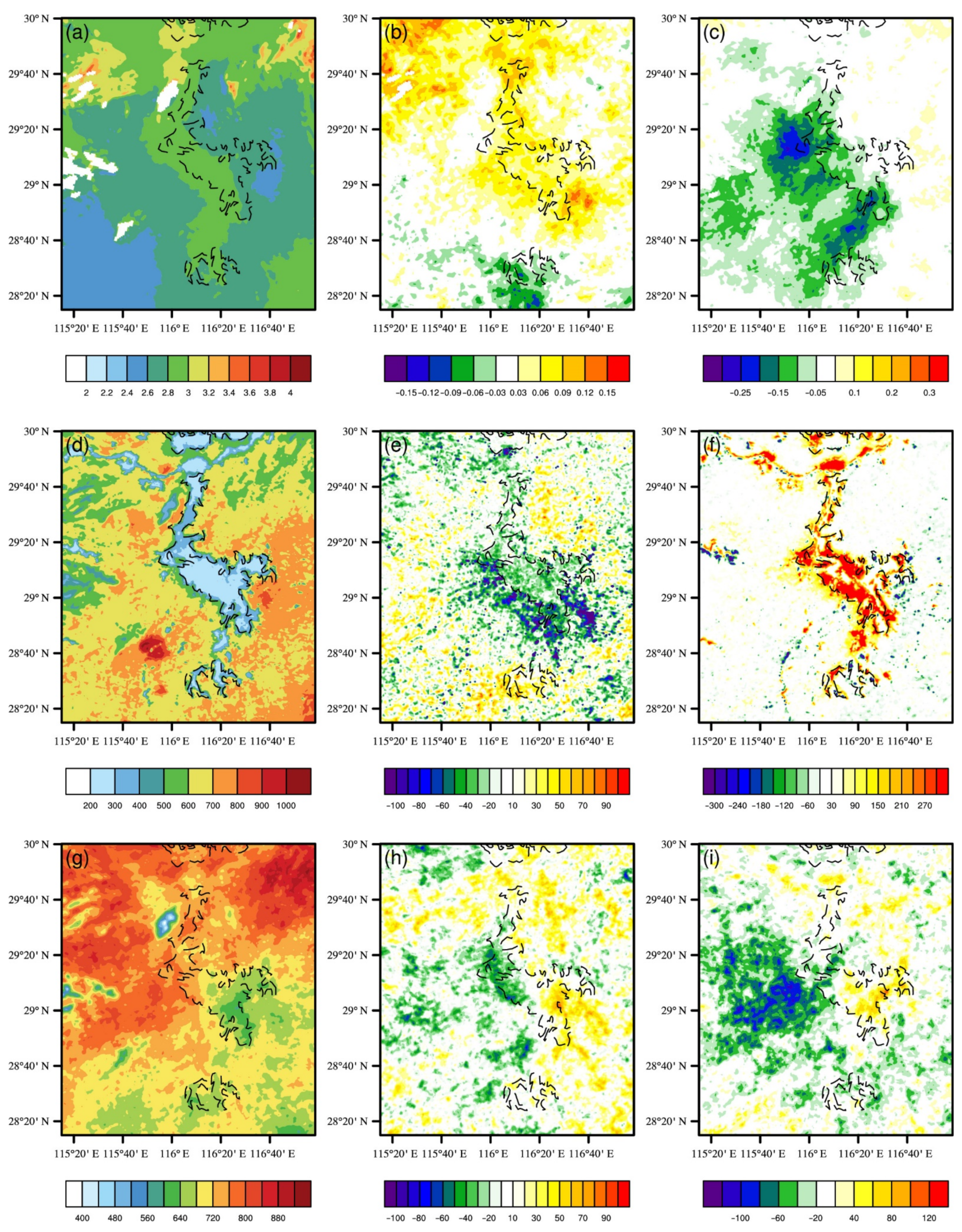

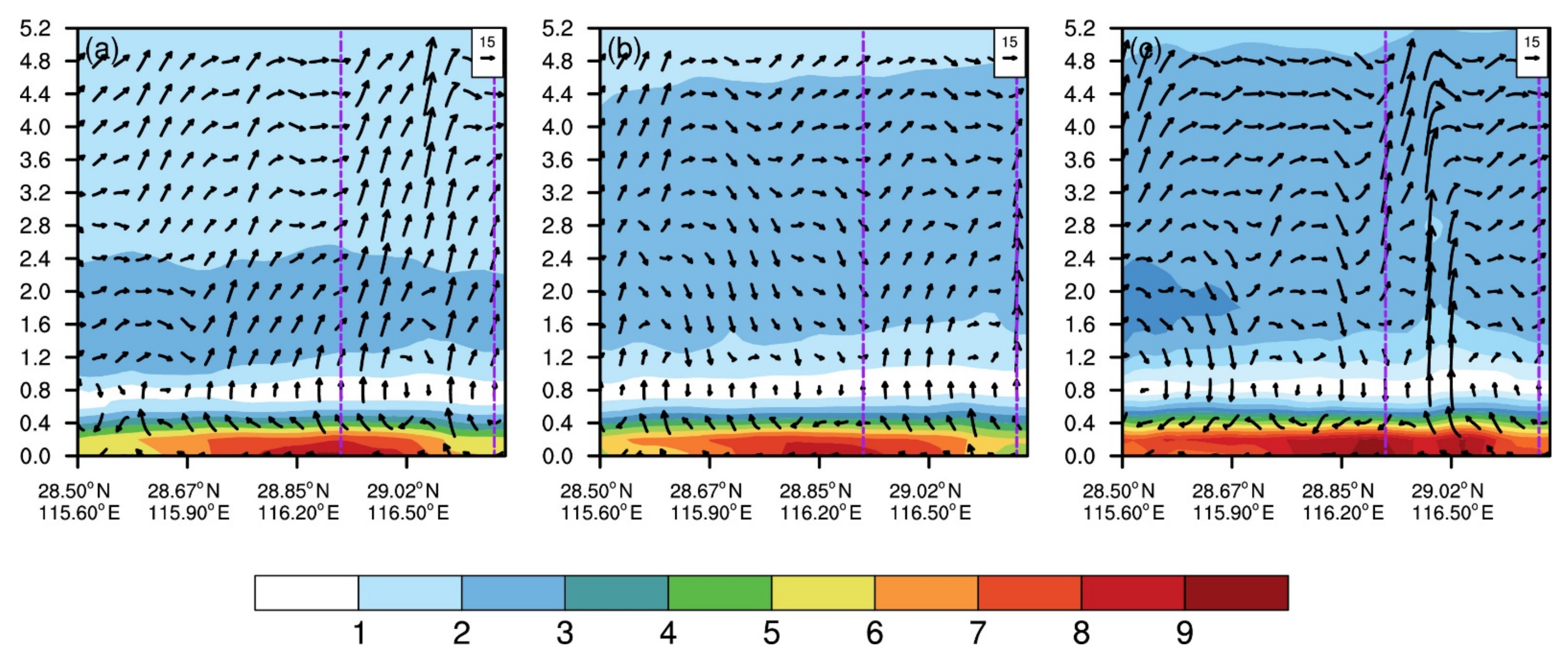
| CTL | EXPT1–CTL | EXPT2–CTL | ||||
|---|---|---|---|---|---|---|
| Domain4 | Rectangular | Domain 4 | Rectangular | Domain 4 | Rectangular | |
| LH | 148.6 | 150.6 | −5.6 | −10.4 | −7.0 | −11.2 |
| SH | 48.1 | 37.1 | 0.8 | −1.1 | 5.2 | 13.4 |
| LST | 30.4 | 30.5 | −0.1 | −0.3 | 0.1 | 0.3 |
| CTL | EXPT1 | EXPT2 | |
|---|---|---|---|
| Wind | 24.0 | 10.8 | 26.2 |
| Precipitation | 89.8 | 67.5 | 66.0 |
Publisher’s Note: MDPI stays neutral with regard to jurisdictional claims in published maps and institutional affiliations. |
© 2022 by the authors. Licensee MDPI, Basel, Switzerland. This article is an open access article distributed under the terms and conditions of the Creative Commons Attribution (CC BY) license (https://creativecommons.org/licenses/by/4.0/).
Share and Cite
Zan, Y.; Gao, Y.; Jiang, Y.; Pan, Y.; Li, X.; Su, P. The Effects of Lake Level and Area Changes of Poyang Lake on the Local Weather. Atmosphere 2022, 13, 1490. https://doi.org/10.3390/atmos13091490
Zan Y, Gao Y, Jiang Y, Pan Y, Li X, Su P. The Effects of Lake Level and Area Changes of Poyang Lake on the Local Weather. Atmosphere. 2022; 13(9):1490. https://doi.org/10.3390/atmos13091490
Chicago/Turabian StyleZan, Yulu, Yanhong Gao, Yingsha Jiang, Yongjie Pan, Xia Li, and Peixi Su. 2022. "The Effects of Lake Level and Area Changes of Poyang Lake on the Local Weather" Atmosphere 13, no. 9: 1490. https://doi.org/10.3390/atmos13091490





